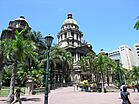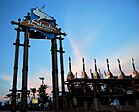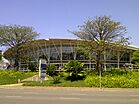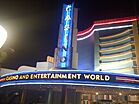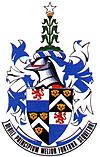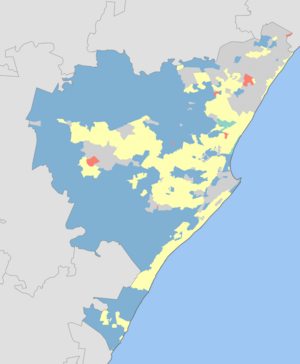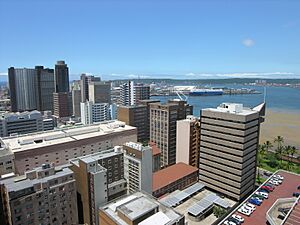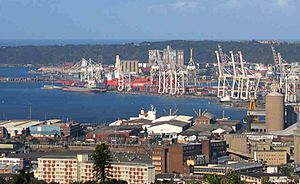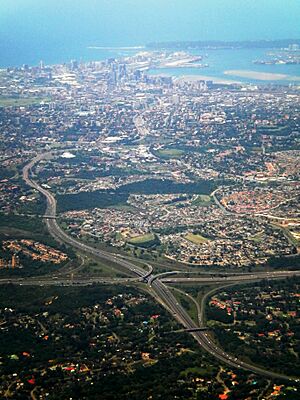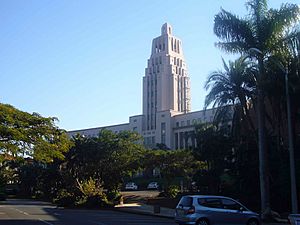Durban facts for kids
Quick facts for kids
Durban
|
|||
|---|---|---|---|
|
Clockwise from top: Durban beachfront (Golden Mile), uShaka Marine World, Suncoast Casino and Entertainment World, Moses Mabhida Stadium, Inkosi Albert Luthuli International Convention Centre, and Durban City Hall
|
|||
|
|||
| Country | |||
| Province | |||
| Municipality | eThekwini | ||
| Established | 24 August 1824 | ||
| Named for | Benjamin D'Urban | ||
| Government | |||
| • Type | Metropolitan municipality | ||
| Area | |||
| • City | 225.91 km2 (87.22 sq mi) | ||
| • Metro | 2,556 km2 (987 sq mi) | ||
| Population
(2011)
|
|||
| • City | 595,061 | ||
| • Rank | 17th in Africa 3rd in South Africa |
||
| • Density | 2,634.06/km2 (6,822.19/sq mi) | ||
| • Metro | 4,239,901 | ||
| • Metro density | 1,658.8/km2 (4,296.3/sq mi) | ||
| Demonym(s) | Durbanite | ||
| Racial makeup (2011) | |||
| • Black African | 51.1% | ||
| • Coloured | 8.6% | ||
| • Indian/Asian | 24.0% | ||
| • White | 15.3% | ||
| • Other | 0.9% | ||
| First languages (2011) | |||
| • English | 49.8% | ||
| • Zulu | 33.1% | ||
| • Xhosa | 5.9% | ||
| • Afrikaans | 3.6% | ||
| • Other | 7.6% | ||
| Time zone | UTC+2 (SAST) | ||
| Postal code (street) |
4001
|
||
| PO box |
4000
|
||
| Area code | 031 | ||
| GDP | US$ 83.9 billion | ||
| GDP per capita | US$ 15,575 | ||
Durban (pronounced DUR-bən), also known as eThekwini in Zulu, is a major city in South Africa. It's the third largest city in the country, after Johannesburg and Cape Town. Durban is located on the east coast of South Africa, right on the Indian Ocean. It has South Africa's busiest port, which means many ships come and go from here.
The city was first seen by European explorers in 1497. English traders set up a trading post in 1824. The Zulu king, Shaka, gave them land around the bay. In 1835, the settlement was named after Sir Benjamin D'Urban, who was the governor of the Cape Colony. Durban officially became a city in 1935.
Durban is a city with a rich mix of cultures. Many people from different backgrounds live here, including Zulu, Indian, White, and Coloured communities. The city is famous for its beautiful beaches and warm weather. It also has many interesting places to visit, like the Golden Mile beachfront, uShaka Marine World, and the Moses Mabhida Stadium. Durban was one of the cities that hosted the 2010 FIFA World Cup.
Contents
Discovering Durban's Past
Durban has a long and interesting history. People lived in this area many thousands of years ago. These early people were hunter-gatherers, meaning they hunted animals and gathered plants for food. Later, the Nguni people settled here.
Early European Visitors
The first European to see the coast of Durban was Vasco da Gama. He was a Portuguese explorer who sailed past the area in December 1497. He named it Natal, which means "Christmas" in Portuguese.
In 1686, a Dutch ship called the Stavenisse crashed off the coast. Some of the survivors found their way to the Bay of Natal. They were helped by the local "Abambo" tribe, led by Chief Langalibalele. The Dutch later bought the Bay of Natal from the Abambo people in 1689.
How Durban Began
In 1824, English traders from the Cape Colony arrived. They were led by Francis Farewell and Henry Fynn. They wanted to set up a trading post at the Bay of Natal.
Henry Fynn became friends with the Zulu King, Shaka. Fynn helped King Shaka recover from an injury. As a thank you, King Shaka gave Fynn a large piece of land around the bay. On August 7, 1824, the English traders officially took control of this land.
The modern city of Durban started in 1824. On June 23, 1835, the European settlers decided to name their new town "D'Urban". They named it after Sir Benjamin D'Urban, who was the governor of the Cape Colony at the time.
Challenges and Changes
In 1839, a group of Dutch settlers called the Voortrekkers created their own republic nearby. This led to some conflict with the British. In 1842, British forces arrived in Durban to take control. After some fighting, the British took over, and Durban became part of the British colony.
Later, from 1860 onwards, many workers from British India came to Durban. This added to the city's diverse population. In 1910, the Natal colony became a province of South Africa. Durban was officially given city status in 1935.
Durban's Location and Weather
Durban is on the eastern coast of South Africa, right next to the Indian Ocean. The Umgeni River flows into the ocean here, marking part of the city's northern border. Durban has a natural harbour, which is the busiest port in South Africa.
The city of Durban is part of a larger area called the eThekwini Metropolitan Municipality. This bigger area includes Durban and many other towns and suburbs that have grown together over time. So, when people say "Durban," they often mean this whole metropolitan area.
What is Durban's Climate Like?
Durban has a humid subtropical climate. This means it has hot and wet summers, and mild, dry winters. You won't usually find frost here! The city gets about 1009 mm (40 inches) of rain each year. In summer, the average temperature is around 24°C (75°F). In winter, it's about 17°C (63°F).
| Climate data for Durban (1961–1990) | |||||||||||||
|---|---|---|---|---|---|---|---|---|---|---|---|---|---|
| Month | Jan | Feb | Mar | Apr | May | Jun | Jul | Aug | Sep | Oct | Nov | Dec | Year |
| Record high °C (°F) | 36.2 (97.2) |
33.9 (93.0) |
34.8 (94.6) |
36.0 (96.8) |
33.8 (92.8) |
35.7 (96.3) |
33.8 (92.8) |
35.9 (96.6) |
36.9 (98.4) |
40.0 (104.0) |
33.5 (92.3) |
35.9 (96.6) |
40.0 (104.0) |
| Mean maximum °C (°F) | 32.6 (90.7) |
31.7 (89.1) |
32.0 (89.6) |
30.4 (86.7) |
30.2 (86.4) |
28.8 (83.8) |
28.9 (84.0) |
29.7 (85.5) |
30.3 (86.5) |
30.5 (86.9) |
30.6 (87.1) |
32.0 (89.6) |
34.5 (94.1) |
| Mean daily maximum °C (°F) | 27.8 (82.0) |
28.0 (82.4) |
27.7 (81.9) |
26.1 (79.0) |
24.5 (76.1) |
23.0 (73.4) |
22.6 (72.7) |
22.8 (73.0) |
23.3 (73.9) |
24.0 (75.2) |
25.2 (77.4) |
26.9 (80.4) |
25.2 (77.4) |
| Daily mean °C (°F) | 24.1 (75.4) |
24.3 (75.7) |
23.7 (74.7) |
21.6 (70.9) |
19.1 (66.4) |
16.6 (61.9) |
16.5 (61.7) |
17.7 (63.9) |
19.2 (66.6) |
20.1 (68.2) |
21.4 (70.5) |
23.1 (73.6) |
20.6 (69.1) |
| Mean daily minimum °C (°F) | 21.1 (70.0) |
21.1 (70.0) |
20.3 (68.5) |
17.4 (63.3) |
13.8 (56.8) |
10.6 (51.1) |
10.5 (50.9) |
12.5 (54.5) |
15.3 (59.5) |
16.8 (62.2) |
18.3 (64.9) |
20.0 (68.0) |
16.5 (61.7) |
| Mean minimum °C (°F) | 17.3 (63.1) |
17.1 (62.8) |
16.1 (61.0) |
12.1 (53.8) |
8.7 (47.7) |
5.9 (42.6) |
5.8 (42.4) |
7.3 (45.1) |
10.0 (50.0) |
11.9 (53.4) |
13.8 (56.8) |
15.9 (60.6) |
5.3 (41.5) |
| Record low °C (°F) | 14.0 (57.2) |
13.3 (55.9) |
11.6 (52.9) |
8.6 (47.5) |
4.9 (40.8) |
3.5 (38.3) |
2.6 (36.7) |
2.6 (36.7) |
4.5 (40.1) |
8.3 (46.9) |
10.3 (50.5) |
11.8 (53.2) |
2.6 (36.7) |
| Average rainfall mm (inches) | 134 (5.3) |
113 (4.4) |
120 (4.7) |
73 (2.9) |
59 (2.3) |
38 (1.5) |
39 (1.5) |
62 (2.4) |
73 (2.9) |
98 (3.9) |
108 (4.3) |
102 (4.0) |
1,019 (40.1) |
| Average precipitation days (≥ 0.1 mm) | 15.2 | 12.9 | 12.6 | 9.2 | 6.8 | 4.5 | 4.9 | 7.1 | 11.0 | 15.1 | 16.0 | 15.0 | 130.3 |
| Average relative humidity (%) | 80 | 80 | 80 | 78 | 76 | 72 | 72 | 75 | 77 | 78 | 79 | 79 | 77 |
| Mean monthly sunshine hours | 184.0 | 178.8 | 201.6 | 206.4 | 223.6 | 224.9 | 230.4 | 217.0 | 173.3 | 169.4 | 166.1 | 189.9 | 2,365.4 |
| Source 1: World Meteorological Organization | |||||||||||||
| Source 2: NOAA (sun, extremes and humidity) | |||||||||||||
Who Lives in Durban?
Durban is a very diverse city, meaning people from many different backgrounds live there. The largest group of people are the Zulus. There are also many people of British and Indian descent. The Indian community has brought a lot of different foods, traditions, and religions to Durban.
After the end of apartheid (a system of racial segregation), many black Africans moved into the city. This caused the population to grow quickly. The government has been working to build more affordable homes for everyone.
In 2011, about 51% of the people in Durban were Black African. About 24% were Indian or Asian, 15% were White, and 8.6% were Coloured. Most people in Durban are of working age, and about 38% are under 19 years old.
Durban's Economy
One of Durban's main industries is sugar refining. KwaZulu-Natal, the province Durban is in, produces most of South Africa's sugar cane.
Durban also has many street vendors and markets. For example, the Warwick Junction Precinct is a lively area where vendors sell everything from traditional medicines to clothes and spices.
Fun Things to Do in Durban
Durban is known as a very green city. It has many parks and nature reserves.
Popular Tourist Spots
There are lots of exciting places to visit in Durban:
- Burman Bush
- Durban Art Gallery
- Durban Botanic Gardens
- Durban Natural Science Museum
- Greyville Racecourse - where the famous Durban July Handicap horse race happens.
- Hawaan Forest
- Kenneth Stainbank Nature Reserve
- Kingsmead Cricket Ground - a big stadium for cricket matches.
- Kings Park Stadium - home to the Sharks rugby team.
- Mitchell Park Zoo
- Moses Mabhida Stadium - a huge stadium built for the FIFA World Cup.
- New Germany Nature Reserve
- Pigeon Valley Nature reserve
- Umgeni River Bird Park
- Umhlanga Lagoon Nature Reserve
- uShaka Marine World - a popular marine theme park.
Cultural Places to Explore
Durban has many museums, art galleries, and theatres.
- The African Art Centre has been helping and promoting African artists since 1960.
- Ethekwini Municipal Libraries is a network of 90 free public libraries. The main library has a special collection of books about Africa.
- The Phansi Museum is in an old mansion. It has one of the largest collections of Southern African art in the world, including old beadwork, pottery, and carvings.
- The Playhouse Theatre is a beautiful theatre built in 1935. It hosts plays, dance shows, and educational programs for schools. Many famous South African playwrights have had their work shown here.
- You can also visit the Durban Art Gallery and the KZNSA - KwaZulu Natal Society of Arts.
Places of Worship
Durban has many different places where people can worship. There are Christian churches and temples, mosques, and Hindu temples. This shows how many different beliefs and traditions are found in the city.
Durban's Buildings and Design
Durban's buildings show its long history. You can see many different styles, from Victorian and Edwardian to more modern designs. Many buildings from the 20th century also have the unique Art Deco style.
News and Radio in Durban
Durban has several daily newspapers, like The Mercury and the Daily News. There are also newspapers in the Zulu language, such as Isolezwe.
The national broadcaster, SABC, has offices in Durban. They run Ukhozi FM, which is one of the biggest radio stations in the world! They also have Radio Lotus, which is for South Africans of Indian origin. Another popular English radio station is East Coast Radio.
Sports in Durban

Durban is a big city for sports!
Rugby
Durban is home to The Sharks rugby team. They play in major competitions and their home ground is the HollywoodbetsKings Park Stadium. Many players from the South Africa national rugby team, the Springboks, play for the Sharks.
Soccer
The city has two soccer clubs in the top league: AmaZulu and Golden Arrows. AmaZulu often play their home games at the Moses Mabhida Stadium.
Cricket
Durban also has a cricket team called the Dolphins. They play at Kingsmead cricket ground. Many famous South African cricketers have played for this team. Durban has hosted big international cricket matches, including games for the 2003 ICC Cricket World Cup.
Other Sports Events
Durban was one of the host cities for the 2010 FIFA World Cup. The city also hosts famous endurance races every year, like the Comrades Marathon (a very long running race) and the Dusi Canoe Marathon.
Getting Around Durban
By Air
King Shaka International Airport is Durban's main airport. It handles both local and international flights. The airport opened in 2010 and is located about 36 km (22 miles) north of central Durban. It's an important airport for travel and trade in South Africa.
By Sea
Durban has been a port city for a very long time. The Port of Durban is one of the busiest ports in South Africa. It's a popular stop for ships needing repairs.
MSC Cruises uses Durban as a base for its cruise ships from November to April each year. You can take cruises from Durban to places like Mozambique, Mauritius, and Madagascar. Durban also has a new, modern cruise terminal that opened in 2019.
By Train
Durban had the first operating steam railway in South Africa, which started in 1860.
- Long-distance trains: Shosholoza Meyl runs passenger trains from Durban to Johannesburg and Cape Town.
- Commuter trains: Metrorail operates trains for people traveling within Durban and the surrounding areas.
By Road
Durban is connected to other parts of South Africa by major roads.
- The N3 Western Freeway links Durban to Gauteng, which is a very important economic area. Many goods are transported by truck on this road to and from the port.
- The N2 Outer Ring Road connects Durban to the Eastern Cape in the south and Mpumalanga in the north. It's also important for linking Durban to coastal towns.
Durban also has many other main roads that connect its different suburbs. In the late 2000s, many streets in Durban were renamed to honor people who were important in the fight against apartheid.
By Bus
Several companies offer long-distance bus services from Durban to other cities. Within Durban, there are also many privately owned buses. Since 2017, the Durban People Mover Bus System has been testing free Wi-Fi for passengers on certain routes.
By Taxi
Durban has two types of taxis:
- Metered taxis: You need to call and order these taxis; they don't usually drive around looking for passengers.
- Minibus taxis: These are a common way for many people to travel. They are often shared by many passengers.
- Ride-sharing apps: Apps like Uber and Taxify are also used by commuters in Durban.
Rickshaws
While not as common for daily travel anymore, rickshaws are still used in Durban. They mostly offer rides to tourists, giving them a fun and traditional way to see parts of the city.
Learning in Durban
Durban has many schools and universities.
Private Schools
- Al Falaah College
- Canaan College
- Clifton School
- Crawford College, La Lucia
- Crawford College, North Coast
- Durban Girls' College
- Eden College Durban
- Highbury Preparatory School
- Hillcrest Christian Academy
- Maris Stella School
- Orient Islamic School
- Reddam House
- Roseway Waldorf School
- St. Henry's Marist Brothers' College
- St. Mary's Diocesan School for Girls, Kloof
- Thomas More College
- T Thunder College
Public Schools
- Brettonwood High School
- Durban Academy High School
- Durban Girls' High School (DGHS)
- Durban High School (DHS)
- Durban North College
- George Campbell School of Technology
- Glenwood High School
- Hillcrest High School
- Kingsway High School
- Kloof High School
- Kloof Junior Primary School
- Kloof Pre-Primary School
- Kloof Senior Primary School
- Northlands Girls' High School
- Northwood School
- Pinetown Boys' High School
- Pinetown Girls' High School
- Port Natal High School
- Queensburgh Girls' High School
- Savannah Park Secondary School
- Westville Boys' High School
- Westville Girls' High School
Universities and Colleges
Durban is home to several universities and colleges, where students can continue their education after school.
- Durban University of Technology
- Mangosuthu University of Technology
- Regent Business School
- University of KwaZulu-Natal
- University of South Africa
- Varsity College (South Africa)
- eta College
Durban's Sister Cities
Durban has "sister city" relationships with many cities around the world. This means they work together on cultural and economic projects.
- Alexandria, Egypt
- Antwerp, Belgium
- Bremen, Germany
- Bulawayo, Zimbabwe
- Chicago, Illinois, US
- Gwangju, South Korea
- Eilat, Israel
- Guangzhou, China
- Le Port, Réunion
- Kaohsiung, Taiwan
- Leeds, United Kingdom
- Maracaibo, Venezuela
- Maputo, Mozambique
- Nantes, France
- New Orleans, Louisiana, US
- Oran, Algeria
- Rotterdam, Netherlands
- Mombasa, Kenya
Famous People from Durban
Many notable people have come from Durban, including:
- Bruce Grobbelaar, a famous footballer.
- Alan Khan, a radio and television presenter.
- Gordon Murray, a well-known engineer and car designer.
- Raoul Hyman, a racing driver.
- Aaron Klug, a Nobel Prize winner.
- Ela Gandhi, a peace activist and granddaughter of Mahatma Gandhi.
- Lara Logan, a journalist.
- Pearl Thusi, an actress.
- Chad Le Clos, an Olympic swimmer.
- Jordy Smith, a professional surfer.
- Penelope Coelen, who was crowned Miss World in 1958.
- Nick Price, a major winning golfer.
- Black Coffee (DJ), a famous DJ and music producer.
- Fernando Pessoa, a poet, writer, and philosopher.
Images for kids
-
Bus transporting supporters during 2010 FIFA World Cup
See also
 In Spanish: Durban para niños
In Spanish: Durban para niños



